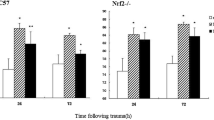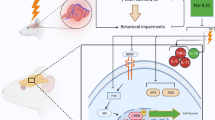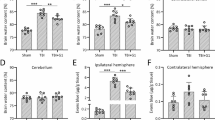Abstract
The role of aquaporin-4 (AQP4) and interleukin-6 (IL-6) in the development of brain edema post-traumatic brain injury (TBI) has been indicated. The present study was designed to investigate the effect(s) of administration of progesterone (P) and/or estrogen (E) on brain water content, AQP4 expression, and IL-6 levels post-TBI. The ovariectomized rats were divided into 11 groups: sham, one vehicle, two vehicles, E1, E2, P1, P2, E1 + P1, E1 + P2, E2 + P1, and E2 + P2. The brain AQP4 expression, IL-6 levels, and water content were evaluated 24 h after TBI induced by Marmarou’s method. The low (E1 and P1) and high (E2 and P2) doses of estrogen and progesterone were administered 30 min post-TBI. The results showed that brain water content and AQP4 expression decreased in the E1, E2, P1, and P2-treated groups. The administration of E1 decreased IL-6 levels. Addition of progesterone decreased the inhibitory effect of E1 and E2 on the accumulation of water in the brain. Administration of E1 + P1 and E1 + P2 decreased the inhibitory effect of E1 on the IL-6 levels and AQP4 protein expression. Our findings suggest that estrogen or progesterone by itself has more effective roles in decrease of brain edema than combination of both. Possible mechanism may be mediated by the alteration of AQP4 and IL-6 expression. However, further studies are required to verify the exact mechanism.




Similar content being viewed by others
Abbreviations
- AQP4:
-
Aquaporin-4
- IL-6:
-
Interleukin-6
- TBI:
-
Traumatic brain injury
- E1:
-
Low dose of estrogen
- P1:
-
Low dose of progesterone
- E2:
-
High dose of estrogen
- P2:
-
High dose of progesterone
- AQPs:
-
Aquaporins
- IL-1β:
-
Interleukin-1β
- NFκB:
-
Nuclear factor kappa b
- OVX:
-
Ovariectomized
- T-PER:
-
Tissue protein extraction reagent
- ELISA:
-
Enzyme-linked immunosorbent assay
- RT-PCR:
-
Reverse transcription-polymerase chain reaction
- β-actin:
-
Beta-actin
- ANOVA:
-
Analysis of variance
- BBB:
-
Blood-brain barrier
- mRNA:
-
Messenger RNA
- HIF-1α:
-
Hypoxia-inducible factor 1-alpha
- MMP-9:
-
Matrix metallopeptidase 9
- RT:
-
Room temperature
References
Agre P, King LS, Yasui M, Guggino WB, Ottersen OP, Fujiyoshi Y, Engel A, Nielsen S (2002) Aquaporin water channels—from atomic structure to clinical medicine. J Physiol 542:3–16
Alexander JJ, Jacob A, Cunningham P, Hensley L, Quigg RJ (2008) TNF is a key mediator of septic encephalopathy acting through its receptor, TNF receptor-1. Neurochem Int 52:447–456
Bloch O, Manley GT (2007) The role of aquaporin-4 in cerebral water transport and edema. Neurosurg Focus 22:E3
Ding Z, Zhang J, Xu J, Sheng G, Huang G (2013) Propofol administration modulates AQP-4 expression and brain edema after traumatic brain injury. Cell Biochem Biophys 67:615–622
Djebaili M, Guo Q, Pettus EH, Hoffman SW, Stein DG (2005) The neurosteroids progesterone and allopregnanolone reduce cell death, gliosis, and functional deficits after traumatic brain injury in rats. J Neurotrauma 22:106–118
Dubal DB, Zhu H, Yu J, Rau SW, Shughrue PJ, Merchenthaler I, Kindy MS, Wise PM (2001) Estrogen receptor alpha, not beta, is a critical link in estradiol-mediated protection against brain injury. Proc Natl Acad Sci U S A 98:1952–1957
Gibson CL, Murphy SP (2004) Progesterone enhances functional recovery after middle cerebral artery occlusion in male mice. J Cereb Blood Flow Metab 24:805–813
Guo Q, Sayeed I, Baronne LM, Hoffman SW, Guennoun R, Stein DG (2006) Progesterone administration modulates AQP4 expression and edema after traumatic brain injury in male rats. Exp Neurol 198:469–478
Higashida T, Kreipke CW, Rafols JA, Peng C, Schafer S, Schafer P, Ding JY, Dornbos D 3rd, Li X, Guthikonda M, Rossi NF, Ding Y (2011) The role of hypoxia-inducible factor-1alpha, aquaporin-4, and matrix metalloproteinase-9 in blood–brain barrier disruption and brain edema after traumatic brain injury. J Neurosurg 114:92–101
Hillman J, Aneman O, Persson M, Andersson C, Dabrosin C, Mellergard P (2007) Variations in the response of interleukins in neurosurgical intensive care patients monitored using intracerebral microdialysis. J Neurosurg 106:820–825
Holmin S, Hojeberg B (2004) In situ detection of intracerebral cytokine expression after human brain contusion. Neurosci Lett 369:108–114
Hu H, Yao HT, Zhang WP, Zhang L, Ding W, Zhang SH, Chen Z, Wei EQ (2005) Increased expression of aquaporin-4 in human traumatic brain injury and brain tumors. J Zhejiang Univ Sci B 6:33–37
Ito H, Yamamoto N, Arima H, Hirate H, Morishima T, Umenishi F, Tada T, Asai K, Katsuya H, Sobue K (2006) Interleukin-1beta induces the expression of aquaporin-4 through a nuclear factor-kappaB pathway in rat astrocytes. J Neurochem 99:107–118
Jain SK, Kannan K, Prouty L, Jain SK (2004) Progesterone, but not 17beta-estradiol, increases TNF-alpha secretion in U937 monocytes. Cytokine 26:102–105
Khaksari M, Soltani Z, Shahrokhi N, Moshtaghi G, Asadikaram G (2011) The role of estrogen and progesterone, administered alone and in combination, in modulating cytokine concentration following traumatic brain injury. Can J Physiol Pharmacol 89:31–40
Kleindienst A, Dunbar JG, Glisson R, Marmarou A (2013) The role of vasopressin V1A receptors in cytotoxic brain edema formation following brain injury. Acta Neurochir (Wien) 155:151–164
Laird MD, Vender JR, Dhandapani KM (2008) Opposing roles for reactive astrocytes following traumatic brain injury. Neurosignals 16:154–164
Leonardo CC, Pennypacker KR (2009) Neuroinflammation and MMPs: potential therapeutic targets in neonatal hypoxic-ischemic injury. J Neuroinflammation 6:13
Lobo RA (1995) Estrogen replacement: the evolving role of alternative delivery systems. Introduction. Am J Obstet Gynecol 173:981
Marmarou A (2007) A review of progress in understanding the pathophysiology and treatment of brain edema. Neurosurg Focus 22:E1
Murphy SJ, Littleton-Kearney MT, Hurn PD (2002) Progesterone administration during reperfusion, but not preischemia alone, reduces injury in ovariectomized rats. J Cereb Blood Flow Metab 22:1181–1188
O'Connor CA, Cernak I, Vink R (2005) Both estrogen and progesterone attenuate edema formation following diffuse traumatic brain injury in rats. Brain Res 1062:171–174
Papadopoulos MC, Verkman AS (2008) Potential utility of aquaporin modulators for therapy of brain disorders. Prog Brain Res 170:589–601
Roof RL, Hall ED (2000) Gender differences in acute CNS trauma and stroke: neuroprotective effects of estrogen and progesterone. J Neurotrauma 17:367–388
Sarkaki AR, Khaksari Haddad M, Soltani Z, Shahrokhi N, Mahmoodi M (2013) Time- and dose-dependent neuroprotective effects of sex steroid hormones on inflammatory cytokines after a traumatic brain injury. J Neurotrauma 30:47–54
Shahrokhi N, Khaksari M, Soltani Z, Mahmoodi M, Nakhaee N (2010) Effect of sex steroid hormones on brain edema, intracranial pressure, and neurologic outcomes after traumatic brain injury. Can J Physiol Pharmacol 88:414–421
Shi WZ, Qi LL, Fang SH, Lu YB, Zhang WP, Wei EQ (2012) Aggravated chronic brain injury after focal cerebral ischemia in aquaporin-4-deficient mice. Neurosci Lett 520:121–125
Shi WZ, Zhao CZ, Zhao B, Zheng XL, Fang SH, Lu YB, Zhang WP, Chen Z, Wei EQ (2012) Aquaporin-4 deficiency attenuates acute lesions but aggravates delayed lesions and microgliosis after cryoinjury to mouse brain. Neurosci Bull 28:61–68
Shin JA, Choi JH, Choi YH, Park EM (2011) Conserved aquaporin 4 levels associated with reduction of brain edema are mediated by estrogen in the ischemic brain after experimental stroke. Biochim Biophys Acta 1812:1154–1163
Simpkins JW, Green PS, Gridley KE, Singh M, de Fiebre NC, Rajakumar G (1997) Role of estrogen replacement therapy in memory enhancement and the prevention of neuronal loss associated with Alzheimer's disease. Am J Med 103:19S–25S
Stein DG (2001) Brain damage, sex hormones and recovery: a new role for progesterone and estrogen? Trends Neurosci 24:386–391
Sun MC, Honey CR, Berk C, Wong NL, Tsui JK (2003) Regulation of aquaporin-4 in a traumatic brain injury model in rats. J Neurosurg 98:565–569
Suzuki S, Brown CM, Wise PM (2009) Neuroprotective effects of estrogens following ischemic stroke. Front Neuroendocrinol 30:201–211
Tait MJ, Saadoun S, Bell BA, Papadopoulos MC (2008) Water movements in the brain: role of aquaporins. Trends Neurosci 31:37–43
Taupin V, Toulmond S, Serrano A, Benavides J, Zavala F (1993) Increase in IL-6, IL-1 and TNF levels in rat brain following traumatic lesion. Influence of pre- and post-traumatic treatment with Ro5 4864, a peripheral-type (p site) benzodiazepine ligand. J Neuroimmunol 42:177–185
Teede HJ (2003) The menopause and HRT. Hormone replacement therapy, cardiovascular and cerebrovascular disease. Best Pract Res Clin Endocrinol Metab 17:73–90
Tomas-Camardiel M, Venero JL, Herrera AJ, De Pablos RM, Pintor-Toro JA, Machado A, Cano J (2005) Blood–brain barrier disruption highly induces aquaporin-4 mRNA and protein in perivascular and parenchymal astrocytes: protective effect by estradiol treatment in ovariectomized animals. J Neurosci Res 80:235–246
Vajda Z, Promeneur D, Doczi T, Sulyok E, Frokiaer J, Ottersen OP, Nielsen S (2000) Increased aquaporin-4 immunoreactivity in rat brain in response to systemic hyponatremia. Biochem Biophys Res Commun 270:495–503
Vajtr D, Benada O, Kukacka J, Prusa R, Houstava L, Toupalik P, Kizek R (2008) Correlation of ultrastructural changes of endothelial cells and astrocytes occuring during blood brain barrier damage after traumatic brain injury with biochemical markers of BBB leakage and inflammatory response. Physiol Res 58:263–268
Vizuete ML, Venero JL, Vargas C, Ilundain AA, Echevarria M, Machado A, Cano J (1999) Differential upregulation of aquaporin-4 mRNA expression in reactive astrocytes after brain injury: potential role in brain edema. Neurobiol Dis 6:245–258
Wang X, Zhang J, Yang Y, Dong W, Wang F, Wang L, Li X (2013) Progesterone attenuates cerebral edema in neonatal rats with hypoxic-ischemic brain damage by inhibiting the expression of matrix metalloproteinase-9 and aquaporin-4. Exp Ther Med 6:263–267
Wise PM, Dubal DB, Wilson ME, Rau SW, Liu Y (2001) Estrogens: trophic and protective factors in the adult brain. Front Neuroendocrinol 22:33–66
Acknowledgments
The present study was supported by neuroscience and physiology research centers of Kerman University of Medical Sciences.
Author information
Authors and Affiliations
Corresponding author
Rights and permissions
About this article
Cite this article
Soltani, Z., Khaksari, M., Shahrokhi, N. et al. Effect of estrogen and/or progesterone administration on traumatic brain injury-caused brain edema: the changes of aquaporin-4 and interleukin-6. J Physiol Biochem 72, 33–44 (2016). https://doi.org/10.1007/s13105-015-0453-5
Received:
Accepted:
Published:
Issue Date:
DOI: https://doi.org/10.1007/s13105-015-0453-5




